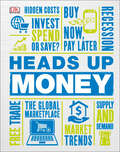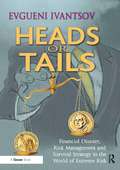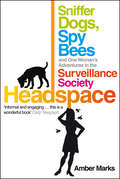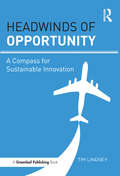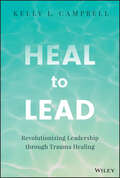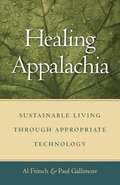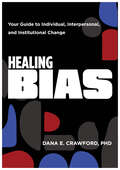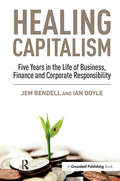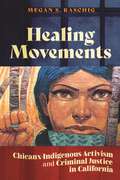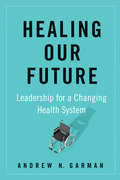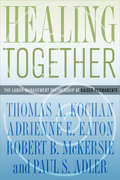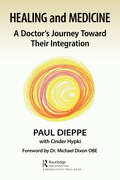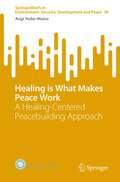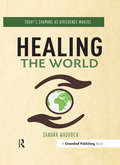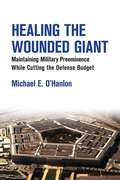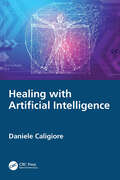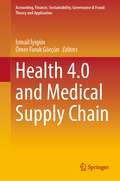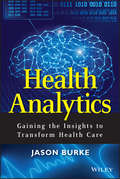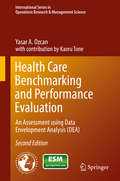- Table View
- List View
Heads Up Money (DK Heads UP)
by DKDoes money make the world go round? Can wealth buy happiness? What would happen if a bank simply printed more money? Find out the answers to these questions and much more in Heads Up Money. Using real-life scenarios, you will learn abou a variety of topics including supply and demand, free trade, globalization, and financial crises. Packed with colorful graphics and easy-to-follow text, this indispensable book will help you understand money and the role it plays in our world.This comprehensive volume also explores international financial institutions, ethical trade, and how to run an efficient and successsful business. Whether you&’re analyzing the global marketplace, studying booming market trends and how to make use of them, calculating hidden costs, or deciding between investing, spending, or saving, Heads Up Money will help you navigate the tricky waters of economics and financial planning.Written by renowned author Marcus Weeks in consultation with Derek Braddon, Professor of Economics at UWE Briston Business School, this book is the perfect introduction to the world of money and finance for teenagers and young adults.
Heads in Beds: A Reckless Memoir of Hotels, Hustles, and So-Called Hospitality
by Jacob TomskyIn the tradition of Kitchen Confidential and Waiter Rant, a rollicking, eye-opening, fantastically indiscreet memoir of a life spent (and misspent) in the hotel industry. Jacob Tomsky never intended to go into the hotel business. As a new college graduate, armed only with a philosophy degree and a singular lack of career direction, he became a valet parker for a large luxury hotel in New Orleans. Yet, rising fast through the ranks, he ended up working in "hospitality" for more than a decade, doing everything from supervising the housekeeping department to manning the front desk at an upscale Manhattan hotel. He's checked you in, checked you out, separated your white panties from the white bed sheets, parked your car, tasted your room-service meals, cleaned your toilet, denied you a late checkout, given you a wake-up call, eaten M&Ms out of your minibar, laughed at your jokes, and taken your money. In Heads in Beds he pulls back the curtain to expose the crazy and compelling reality of a multi-billion-dollar industry we think we know. Heads in Beds is a funny, authentic, and irreverent chronicle of the highs and lows of hotel life, told by a keenly observant insider who's seen it all. Prepare to be amused, shocked, and amazed as he spills the unwritten code of the bellhops, the antics that go on in the valet parking garage, the housekeeping department's dirty little secrets--not to mention the shameless activities of the guests, who are rarely on their best behavior. Prepare to be moved, too, by his candor about what it's like to toil in a highly demanding service industry at the luxury level, where people expect to get what they pay for (and often a whole lot more). Employees are poorly paid and frequently abused by coworkers and guests alike, and maintaining a semblance of sanity is a daily challenge.Along his journey Tomsky also reveals the secrets of the industry, offering easy ways to get what you need from your hotel without any hassle. This book (and a timely proffered twenty-dollar bill) will help you score late checkouts and upgrades, get free stuff galore, and make that pay-per-view charge magically disappear. Thanks to him you'll know how to get the very best service from any business that makes its money from putting heads in beds. Or, at the very least, you will keep the bellmen from taking your luggage into the camera-free back office and bashing it against the wall repeatedly.
Heads or Tails: Financial Disaster, Risk Management and Survival Strategy in the World of Extreme Risk
by Evgueni IvantsovIn the wake of the global financial crisis, Heads or Tails answers the question: what changes should financial institutions undergo to ensure reliable protection against extreme risks? Recent massive failures among large and respected financial institutions, clearly demonstrate that contemporary risk management and regulation fail to provide adequate responses to the challenges set by extreme risks. Dr Evgueni Ivantsov combines analysis of the nature of extreme risk (so-called tail risk), risk management practices and practical solutions to build a robust, enterprise-wide, extreme risk management framework which includes three lines of defence, ranging from strategic to tactical, designed to help address the tail risk during different stages of its development. The author also discusses: ¢ Why modern ’sophisticated’ risk management frameworks, strong capitalisation and liquidity do not prevent banks from failure in the face of systemic crisis; ¢ What it means to build an effective defence against systemic and catastrophic losses; ¢ What risk architecture should look like to ensure that extreme risk events are identified early and efficiently mitigated; ¢ How modern management practices, regulation and risk and business culture need to change to guarantee sustainability. While the context of Dr Ivantsov’s writing is financial services, the book contains an important message for specialists from any industries exposed to the extreme risks (oil/gas, energy, mining, chemical productions, transportation, etc.). Until the shortcomings of current risk management and regulation are resolved, financial services and other at risk industries will repeat the painful mistakes of the past, over and over again.
Headspace vs. Calm: A Mindful Competition
by Ayelet Israeli Anne WilsonBy 2021, the mindfulness app wars reached their apex. Over 2,000 meditation apps were available to consumers, but two apps, Headspace and Calm, dominated the space, jointly holding about 70% of the total market. Headspace had established itself as the approachable educator for novice meditators. Headspace also invested heavily in athletics partnerships, business-to-business services, and in creating Headspace Health, which they hoped would gain FDA approval and become the first prescription meditation app. Meanwhile, Calm had earned a reputation as the soothing sleep app. Calm was also known for its numerous partnerships with A-list celebrities such as Matthew McConaughey, Harry Styles, and Idris Elba. Indeed, Calm was focused on becoming the leader in "calmtainment" and making a home for itself in Hollywood. What does the future hold for the rivalry between Calm and Headspace? Will both brands continue to co-dominate the mindfulness and meditation space or will one ultimately prevail? What should the brands do to maintain their co-dominance or edge out the other and claim the number one spot?
Headspace: Sniffer Dogs, Spy Bees and One Woman's Adventures in the Surveillance Society
by Amber MarksCrime detection has gone to the dogs and squirrels are being busted for espionage. If you've never wondered about the new direction of 'intelligence-led policing' in our society, now is the time to start. It was a chance encounter with a police sniffer-dog that drew criminal lawyer Amber Marks into the hidden world of the science of smell and its law-enforcement applications. Soon she stumbled into a wonderland of contemporary surveillance, where the spying skills of bees, dolphins and a myriad other critters were being harnessed to build a 'secure world' of bio-intelligence. From the businesses, scientists and military departments developing new smell-based surveillance technologies, to good old-fashioned police dogs, Amber discovered a secret world of security forces, where animals and scent are as important as intelligence agents and CCTV.Part polemical exploration of our burgeoning surveillance society, part humorous memoir, this intriguing book will capture your imagination and get you wondering: just who stands to benefit from all this 'security'?
Headstrong and Unorthodox Pioneers for a Critical Theory of Consumption: Contributions from Economics and Social Sciences
by Karl Kollmann Michael-Burkhard PiorkowskyThis volume offers contributions on the fundamentals of current consumption theory and consumption research, which have developed almost entirely from originally unorthodox approaches against traditional micro- and macroeconomic theory. The inspiration came mainly from social economic behavioural research and ecological economics. But the reception is very patchy and the history is largely forgotten. With reference to the work of earlier authors, new arguments are offered to the current discussion about delimitations and paradoxes in consumption and the still narrowly understood consumer role. It is as much about rework in sharpening the understanding of consumption and consumers in their lifeworlds as it is about indications of fruitfulness for the analysis of open questions. It is about arguments for a paradigmatic reorientation of consumer research and policy. The contributions address in particular ambivalences, options and future modes in consumption in the search for individual satisfaction and ecological sustainability.This book is a translation of an original German edition. The translation was done with the help of artificial intelligence (machine translation by the service DeepL.com). A subsequent human revision was done primarily in terms of content, so that the book will read stylistically differently from a conventional translation.
Headwinds of Opportunity: A Compass for Sustainable Innovation
by Tim LindseyWinner of the Silver Axiom Business Book Award in the category of Sustainability. Headwinds of Opportunity goes beyond philosophical and academic discussion of business sustainability to offer strategic guidance regarding how to make all types of organizations function more sustainably while simultaneously improving their competitiveness. It differs from other books in that it approaches sustainability as an innovation – an innovative way of conducting business. The book is informed by time-tested principles of innovation diffusion that can be effectively applied to drive change. It places considerable emphasis on the "how-to" aspects of sustainability improvement and how they can be used to increase effectiveness.
Heal to Lead: Revolutionizing Leadership through Trauma Healing
by Kelly L. CampbellBy taking radical responsibility for your own healing, you unveil the high-conscious leader within that our world needs right now. You don’t outrun or outgrow the formative experiences that have shaped who you are. So, it makes sense that your emotional history would also be the foundation of your leadership style. If what got you to this point may now be the very thing that is holding you back, then Heal to Lead was written for you. Everything you’ve read about conscious leadership is based on self-awareness and personal growth, yet the missing link has been trauma healing. If you want greater collaboration with your people, the confidence to inspire growth in your organization, and a more meaningful connection to yourself, your community, and the natural world, it’s time to do the inner work. This book shows you how to develop high-conscious leadership, rooted in deep introspection, vulnerability, compassion, and reciprocity with all beings. Inside, former CEO turned trauma-informed leadership coach Kelly L. Campbell walks alongside you as you unpack and process what’s been buried within your psyche. Integrating your past trauma is the key to unlearning the maladaptive strategies that have kept you subconsciously safe until now. With the resources, personal anecdotes, and reflection questions in this book, you will be better able to regulate your emotions and feel more enlivened as you lead from a place of reclamation. As an indicator of your commitment, your organization will ultimately realize greater stability and success. Discover how trauma lives in the body and can hinder you from accessing your potential. Break strategic patterns in your life that keep you automated, and gain clarity about what you are here to contribute. Develop greater compassion for yourself and others so you can co-create healthy workplace culture and respond productively in difficult situations. Make a lasting, positive impact within your organization and augment your bottom line. Disrupt the default of extractive, patriarchal, and supremacist business practices. Commit to taking part in the restoration of our societal tapestry and global environment. Heal to Lead is a radical departure from the myths that emerging and established leaders like you have been fed for so long. By healing your core wounds, you shed other people’s stories about who you are, releasing the pain and scarcity mindset that keeps you feeling stuck. This liberation finally gives you access to your innate gifts as a leader, and you feel empowered to do the right thing by all as a generative force in the world.
Healing Appalachia: Sustainable Living through Appropriate Technology
by Al Fritsch Paul GallimoreHealing Appalachia is a practical guide for environmentally conscious residents of Appalachia and beyond. Each section of the book includes details on construction and maintenance, as well as resources for locating further information, making this an essential volume for everyone who cares about the future of Appalachia.
Healing Bias: Your Guide to Individual, Interpersonal, and Institutional Change
by Dana E. CrawfordBlends CBT and interpersonal therapy principles for implementable actions to reduce bias. Everyone has biases, yet most people are unable to discuss them openly without feelings of shame, stigma, and defensiveness. Although perceived as flaws or a question of one’s character, these biases should be viewed as socially constructed coping mechanisms shaped by trauma, stress, and the need to survive. Only when redefined will we be able to have honest conversations about and reductions in bias, race, and prejudice. Dana Crawford’s Crawford Bias Reduction Theory & Training (CBRT) invites readers on a transformative journey to understand, research, and reduce bias at the internal, relational, and systemic levels. Her three-pronged approach starts with the awareness phase which focuses on self-reflection and group interaction through empathy, compassion, and accountability. The investigation phase will help readers recognize and dissect bias within themselves, with others, and in society. Lastly, the reduction phase further develops skills to confront and mitigate bias with exercises like role-play and real-play scenarios. With reflection prompts, personal stories, actionable advice, and examples inspired by actual events, Healing Bias translates complex ideas into relatable, empowering solutions that can be used on your own or in group settings. This guide can be used with the Racial Awareness Conversations for Everyone (R. A. C. E.) card deck to enhance self-reflection and group discussion with questions based on the CBRT model.
Healing Capitalism: Five Years in the Life of Business, Finance and Corporate Responsibility
by Jem Bendell Ian DoyleThe global response from business to social and environmental issues during the past decade has created a corporate responsibility movement. But what has been the impact of this movement? The financial crisis that began in 2007 has led more and more people to question the fundamentals of our economic system. Now, some within the corporate responsibility movement are developing a vision and practice of a new form of capitalism, one that will require collective action to achieve. Bendell and Doyle draw on Lifeworth's annual reviews of corporate responsibility and explain how business leaders, stakeholders and related academe now need to experiment with new models that address the fundamental flaws of contemporary capitalism, including monetary systems, enterprise ownership, and regulation. This book will be a fantastic resource for business libraries, as it records and analyses key events, issues and trends in corporate responsibility during the first decade of the 21st century. It is a sequel and companion to Bendell's previous work, The Corporate Responsibility Movement.
Healing Movements: Chicanx-Indigenous Activism and Criminal Justice in California
by Megan S. RaschigHow a grassroots abolitionist project of cultural healing counters the carceral state in a Chicanx community in CaliforniaFor many, gang involvement can be a guaranteed life sentence, a force which traps them in an inescapable cycle of violence even if it does not lead to actual prison time. Healing Movements explores the work of formerly gang-involved Chicanx men and women in California who draw on the social connections made during their gang-involved years to forge new pathways for cultural healing and countering the carceral system.Known colloquially as the “movement of healing,” this Chicanx-Indigenous abolitionist project based in Salinas, California, was spurred on by a series of four police homicides of Latino men in 2014. Organizing around such issues as police brutality and mass incarceration, these collectives—two of which are discussed in this book, one mixed-gender, and the other women-only—turned to their often obscured Mesoamerican ancestry to find new resources for building a different future for themselves and subsequent generations.Drawing on extensive fieldwork conducted in Salinas, Healing Movements reveals how these communities have taken shape in large part through a conscious effort to uplift Chicanx-Indigenous culture and ceremonial practices. By tapping into their Indigeneity, the members of these collectives access a wealth of new resources to shape their future, opening up novel ways to organize and build strong relational ties that are noteworthy to anyone invested in abolitionist work.
Healing Our Future: Leadership for a Changing Health System
by Andy GarmanThis book is a practical, evidence-based guide to seven key leadership disciplines that will help anyone working in healthcare to pursue brighter futures.In this book, Andrew Garman looks at the major changes facing healthcare organizations and the leadership competencies required to successfully meet those challenges. He explains how people become more effective leaders over time and what science tells us works best in making this happen. At the heart of this book are seven universal disciplines—values, health system literacy, self-development, relations, execution, boundary-spanning, and transformation—which Garman divides into "enabling" and "action" disciplines. The enabling disciplines encompass the foundational work that makes leadership efforts more effective: learning more about ourselves, deepening our understanding of the world around us, and taking care of ourselves. The action disciplines describe leadership in the context of getting the work done: setting and resetting direction, collaborating inside and outside our organizations, anticipating what's coming, and helping people prepare for it. Collectively, they form an evidence-based common language of leadership that readers can easily map to any model that their organization or profession may already be using. Each chapter provides a description of the discipline, illustrates why it is important, and offers specific advice on how to raise proficiency. Appendixes offer step-by-step guidance on recruiting and engaging good mentors, along with input on developing long-term and foresight skills.
Healing Together
by Thomas A. Kochan Adrienne E. Eaton Robert B. Mckersie Paul S. AdlerKaiser Permanente is the largest managed care organization in the country. It also happens to have the largest and most complex labor-management partnership ever created in the United States. This book tells the story of that partnership-how it started, how it grew, who made it happen, and the lessons to be learned from its successes and complications. With twenty-seven unions and an organization as complex as 8. 6-million-member Kaiser Permanente, establishing the partnership was not a simple task and maintaining it has proven to be extraordinarily challenging. Thomas A. Kochan, Adrienne E. Eaton, Robert B. McKersie, and Paul S. Adler are among a team of researchers who have been tracking the evolution of the partnership between Kaiser Permanente and the Coalition of Kaiser Permanente Unions ever since 2001. They review the history of health care labor relations and present a profile of Kaiser Permanente as it has developed over the years. They then delve into the partnership, discussing its achievements and struggles, including the negotiation of the most innovative collective bargaining agreements in the history of American labor relations. Healing Together concludes with an assessment of the Kaiser partnership's effect on the larger health care system and its implications for labor-management relations in other industries.
Healing and Medicine: A Doctor's Journey Toward Their Integration
by Paul DieppeHealing is on many people’s minds today. In the wake of the COVID-19 pandemic and a host of other disruptions and disasters, many of us feel that we need healing – in our personal lives, for the environment and for our planet. But healing is rarely defined and is not an accepted part of medicine in the West. This book examines the relationship between healing and medicine through the eyes of an academic physician who changed his interests from biomedical research to healing late in his career in medicine. It is based on his experiences and stories of his encounters with patients, practitioners and others for whom healing has had a particular significance, as well as his rigorous research into the subject. A central theme of the book is that modern medicine needs to be more pluralistic in its approach to health and accept that spirituality and healing techniques have roles to play alongside scientific medicine, which currently has its base in materialism alone.
Healing is What Makes Peace Work: A Healing-Centered Peacebuilding Approach (SpringerBriefs in Environment, Security, Development and Peace #39)
by Angi Yoder-MainaThe book goes beyond mental health and psychosocial support (MHPSS) to a holistic approach centered on healing. The book lays at the intersection of peacebuilding, global mental health, and development. In many parts of the world, entire generations live in chronic violence—just surviving. The exposure to violence has long-lasting effects which are not well accounted for in conflict analysis, stabilization efforts, peacebuilding, and governance initiatives. Extreme exposure to violence, abuse, neglect, and marginalization negatively affects levels of resilience and the ability of affecting the transition from violence to peace. A healing-centered peacebuilding approach requires fundamental changes in how systems are designed, organizations function, and practitioners engage with people, their communities, and their institutions. Key elements of the practice-based approach included inclusion, customization and contextualization, breaking cycles of violence, systems thinking, and trauma-informed tools. The approach considers emotional distress to be a critical variable in violent conflict and instability. Trauma is not only a consequence of violence, but also a cause of instability.
Healing the 800-Pound Gorilla: The Future of Health Care
by Clayton M. Christensen Scott D. Anthony Erik A. RothThis chapter examines whether theories of innovation apply to health care. One possible root cause of the health care crisis is a focus on the wrong kind of quality. In fact, today's one-size-fits-all system does a poor job of meeting patients' varying demands for quality. Disruptive innovations can help address these problems.
Healing the Downsized Organization: What Every Employee Needs to Know About Today's New Workplace
by Delorese AmbroseHealing the Downsized Organization is for managers and employees who must make sense of dramatically changed workplaces after reengineering, restructuring, or downsizing. Here are "best practices" from those who are successfully reinventing their organizations and re-creating healthy workplaces. Documented examples from executives, managers, and employees who have bounced back from this challenge reveal how they minimized pain during downsizing and discovered promising possibilities for changed employer-employee relationships. Dramatic profiles of four organizations--representing manufacturing, media journalism, education, and health care--provide lessons you can practice today, whether downsizing is unfolding now or whether it looms in the future. From interviews with CEOs, managers, and employees, you will understand how individuals at all levels have handled the tension between personal and organizational goals, managed the human struggles, and achieved victories as they cut costs and redeployed resources to face competition or changing market conditions. You will learn how these companies and individuals coped with downsizing, including: ¸ how "survivors" regained momentum, focus, and job satisfaction after downsizing ¸ what kinds of company-employee interactions allowed trust to be rebuilt ¸ how managers succeeded in balancing the concerns of those who left and those who stayed ¸ ways to be an effective leader in the transitional period ¸ approaches to forge a new employer-employee social contract for the emerging workplace Healing the Downsized Organization is the recovery book for the downsizing of America. From the Hardcover edition.
Healing the World: Today's Shamans as Difference Makers
by Sandra WaddockOur world is fraught with problems that demand attention: climate change, terrorism, poverty, and injustice to name only a few. Healing the World takes the fundamental teachings of shamans—the healer of communities—and applies them to the problems of today, using terms and concepts that anybody, from business leaders to activists, can relate to and understand. It helps people identify their own gifts and find the pathways forward to using those gifts in the world, no matter what their occupation, civic activity, or interests.
Healing the Wounded Giant
by Michael E. O'HanlonPresident Barack Obama survived a tenuous economy and a toxic political environment to win re-election in 2012, but the bitter partisan divide in Washington survived as well. So did the country's huge fiscal deficit. in this, the latest in a long line of Brookings Institution analyses of the defense budget, Michael O'Hanlon considers how best to balance national security and fiscal responsibility during a period of prolonged economic stress and political acrimony-even as the world remains unsettled, from Afghanistan to Iran to Syria to the western Pacific region.O'Hanlon explains why the large defense cuts that would result from prolonged sequestration or from deficit-reduction projects such as the Bowles-Simpson plan are too deep. But the bulk of his book represents an effort to look for greater savings than the Obama administration's 2012 proposals would allow.
Healing the Wounds
by David M. NoerFrom the founder of "layoff survivor sickness" an updated edition of a book for today's downsized workforceThoroughly revised and updated, David Noer's classic book about downsized organizations has never been more relevant. Reports of the most recent layoffs are making the front pages of our newspapers with frightening regularity. And massive downsizing continues to reshape the face of American business. But what about those who remain behind? Healing the Wounds provides an antidote to the widespread malaise on the American business scene left in the wake of workforce reductions. Drawing on case studies and original research, David M. Noer-an expert frequently quoted in major media such as The Wall Street Journal and Fortune on the topic of layoffs and layoff survivor sickness-provides executives, human resource professionals, managers, and consultants with an original model and clear guidelines for revitalizing downsized organizations and the employees left behind.Offers thoroughly revised edition of a book about layoffs and those who are left behindFilled with relevant case studies and recent researchWritten by David Noer an acclaimed expert on the topicGives employers much-needed guidance for revitalizing downsized companies
Healing with Artificial Intelligence
by Daniele CaligioreDiagnosis through images, robot surgeons, digital twins, and the metaverse are some of the applications in which artificial intelligence (AI) is involved. It is an almost sci-fi world that touches us closely and toward which we can harbor both great hopes and great fears. Health, in fact, is a central theme, and understanding how this new technology can help us to heal, acquire well-being, and live better is certainly important. This book, thanks to the author’s great experience, deals comprehensively and accessibly with the benefits and risks of using AI in the field of health. It will enable the reader to confidently approach a revolution that will change the way we treat ourselves.
Health 4.0 and Medical Supply Chain (Accounting, Finance, Sustainability, Governance & Fraud: Theory and Application)
by İsmail İyigün Ömer Faruk GörçünThis book examines the new developments in health 4.0 and the medical supply chain. Although supply chain applications in health systems are similar to other sectors, the most critical difference is that any disruption affects public health. There have been changes due to COVID-19 that caused significant disruptions in the supply chain of almost all sectors. The health sector is one of the most important sectors affected by all these extraordinary conditions. Supply chain management is even more critical because the health sector directly impacts the sustainability of human life and the provision of better living conditions. In this book, the use of artificial intelligence in the health and medical supply chain is discussed, taking into account the conditions of the post-pandemic period.
Health Analytics: Gaining the Insights to Transform Health Care
by Jason BurkeA hands-on, analytics road map for health industry leaders The industry-wide transformation taking place across the health and life sciences ecosystem is mandating that organizations adopt new decision-making capabilities, based on science and real-world information. Analytics will be a required competency for the modern health enterprise; this book is about how to "cross the chasm." The ultimate analytics guide for the health industry leader, this essential book equips business leaders with little-to-no experience in analytics to understand how to incorporate analytics as a cornerstone of their 21st century competitive business strategy. Paints the picture for a new health enterprise, one focused on the patient Explores the financial components of this new operating model, using analytics to optimize the tradeoffs between cost and value Deals with the rising role of the consumer, using analytics to create a completely new health engagement model with individual recipients of care Looks at how analytics can drive innovations in care practice, patient-experienced medical outcomes, and analytically driven novel therapies optimized for the individual patient Presents a variety of text, tables, and graphics illustrating the various concepts being described Within each section and chapter, Health Analytics assesses the current landscape, proposing a new model/concept, sharing real-world stories of how the old and new world come together, and framing a "how-to" for the reader in terms of growing that particular set of capabilities in their own enterprises.
Health Care Benchmarking and Performance Evaluation
by Yasar A. OzcanThis new edition continues to emphasize the use of data envelopment analysis (DEA) to create optimization-based benchmarks within hospitals, physician group practices, health maintenance organizations, nursing homes and other health care delivery organizations. Suitable for graduate students learning DEA applications in health care as well as for practicing administrators, it is divided into two sections covering methods and applications. Section I considers efficiency evaluations using DEA; returns to scale; weight restricted (multiplier) models; non-oriented or slack-based models, including in this edition two versions of non-controllable variable models and categorical variable models; longitudinal (panel) evaluations and the effectiveness dimension of performance evaluation. A new chapter then looks at new and advanced models of DEA, including super-efficiency, congestion DEA, network DEA, and dynamic network models. Mathematical formulations of various DEA models are placed in end-of-chapter appendices. Section II then looks at health care applications within particular settings, chapter-by-chapter, including hospitals, physician practices, nursing homes and health maintenance organizations (HMOs). Other chapters then explore home health care and home health agencies; dialysis centers, community mental health centers, community-based your services, organ procurement organizations, aging agencies and dental providers; DEA models to evaluate provider performance for specific treatments, including stroke, mechanical ventilation and perioperative services. A new chapter then examines international-country-based applications of DEA in health care in 16 different countries, along with OECD and multi-country studies. Most of the existing chapters in this section were expanded with recent applications. Included with the book is online access to a learning version of DEA Solver software, written by Professor Kaoru Tone, which can solve up to 50 DMUs for various DEA models listed in the User's Guide at the end of the book.
